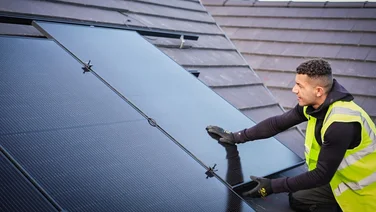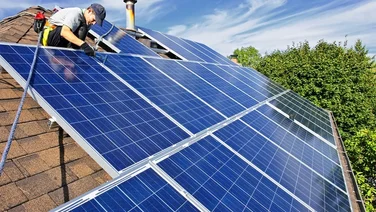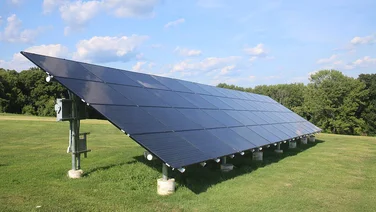- What are Contracts for Difference?
- How does the Contracts for Difference scheme work?
- Why did the government create the Contracts for Difference scheme?
- Does the Contracts for Difference scheme increase your bills?
- Advantages and disadvantages of Contracts for Difference
- Has Contracts for Difference been a success so far?
- Summary
- The Contracts for Difference scheme encourages green energy production
- It guarantees a fixed rate of return for investors
- Generators have to triumph in a lowest-bid-wins auction to secure a contract

Wind turbines, hydropower plants, and solar panels cost a fair amount, so renewable energy generators prefer to have assurances they’ll make a certain level of profit before investing.
Without these guarantees, the amount of renewable power they produce could stay low, which would mean less green energy for suppliers to purchase from them.
That’s where the Contracts for Difference government grants for solar panels comes into play.
This guide will explain what this scheme is, how it works, and whether it’s good for UK households.
If you want to see if you could save money by producing renewable energy, it’s simple to compare solar panel prices with our help. Just provide a few quick details, and our expert installers will be in touch with free quotes for you to compare.
Where do you want to install solar panels?
Get startedWhat are Contracts for Difference?
Contracts for Difference are long-term contracts that compel a generator to provide a certain amount of low-carbon electricity in exchange for a flat rate that’s tied to inflation.
From the government’s perspective, this guarantees a consistent supply of low-carbon energy – usually for 15 years – while the generator can safely invest in renewable technology in return for a steady, inflation-resistant source of income.
And for you as a consumer, it means suppliers won’t have any extra reasons to raise your electricity bills when the energy market gets volatile. It’s a win-win-win, in theory.
Currently, generators are allowed to bid if they produce energy through anaerobic digestion, biogas, biomass, combined heat and power, geothermal, hydropower, landfill gas, tidal or wave power, offshore wind, onshore wind, sewage gas, or solar panels.
One of the most common questions we get asked is: what are the best solar panels? The answer will depend on your budget, your energy output and your home, among other things. To find the best solar panel for you, visit our dedicated page.
How does the Contracts for Difference scheme work?
There are two main stages to the Contracts for Difference scheme: the auction process through which contracts are handed out, and the execution of the contracts.
1. Contracts are awarded
The government-owned Low Carbon Contracts Company (LCCC) awards Contracts for Difference to large-scale generators in Britain once per year, through a competitive auction.
The Department for Energy Security and Net Zero sets the capacity and budget for the auction, including placing maximum caps on bid amounts for different green technologies.
This ensures that generators can’t overcharge for the energy they’ll produce if they win – though the government can’t set these caps too low, or risk receiving no bids.
Generators then submit sealed bids to National Grid ESO (Electricity System Operator), which runs the auction, along with the details of their proposed projects.
The lowest bid in each category wins that company a Contract for Difference, which is signed by the LCCC. If more than one bid in a category – e.g. solar power – is successful, all the winning companies are paid the same amount for their energy.
2. Contracts are fulfilled
When the generator produces renewable energy at the level in its contract, it receives payment at the strike price – the agreed amount a generator is paid for the energy it produces.
When the wholesale cost of electricity, called the reference price, is below the strike price included in a Contract for Difference, the LCCC gives the generator top-up payments to meet the strike price level.
And if the reference price is above the strike price, the generator will pay the difference back to the LCCC, which funnels this money back to energy suppliers.
This means that whatever amount energy suppliers pay generators for their renewable electricity, generators will ultimately receive the strike price in any and all situations.
A government tax on suppliers funds payments to renewable generators when the reference price is below the strike price.
This means the Contracts for Difference scheme is funded by taxpayers – as most government initiatives are.
Why did the government create the Contracts for Difference scheme?
The Conservative-Liberal Democrat coalition government created the Contracts for Difference scheme in 2014 to encourage electricity generators to go green, both to lower energy costs and to fight climate change.
The scheme helps to convince generators to invest in low-carbon technology and infrastructure, because they can secure a guaranteed return on this outlay.
A generator can lower the costs of production – and therefore the market price of electricity – by investing in research and development, while sitting pretty with its locked-in Contract for Difference.
The costs of producing renewable energy like solar and wind power have declined dramatically in recent years, according to government data.
With this trend set to continue, generators are incentivised to secure relatively high long-term prices for their green energy.

Does the Contracts for Difference scheme increase your bills?
The Contracts for Difference scheme does not raise your bills overall.
A tiny percentage of your energy bills does go towards paying for the initiative – at the current price cap, it’s £15 of the average three-bedroom household’s annual bill.
However, the scheme has significantly increased low-carbon energy generation on these shores, which increases our energy independence and keeps bills down.
The Energy & Climate Intelligence Unit’s Jess Ralston recently told Sky News that Contracts for Difference “are actively helping to limit electricity price increases by reducing the need to import expensive gas from places like Russia and essentially funding Putin’s war.”
And when we’re in an energy crisis – as we currently are – and prices rise rapidly, the reference price rises above the strike price and generators have to hand over the difference between the two prices to the LCCC.
This means there’s no need for the associated tax on energy suppliers – so it drops to zero.
This lowers costs for suppliers at just the right time, enabling them to lower domestic energy bills – though whether they actually do so is up to them.
In a recent report, the LCCC wrote: “Once LCCC has paid the surplus to suppliers, it is up to them as to how that cash is used, but it should have mitigated the bill rises we have seen since last year to a small extent.”
The main mechanisms for keeping energy bills down are still legal limits like the energy price cap or Energy Price Guarantee – but the Contracts for Difference scheme doesn’t hurt.
Advantages and disadvantages of Contracts for Difference
- It reduces risks for investors and companies
- It leads to more low-carbon energy
- It lowers energy bills overall
- Low bid caps can put off companies
Advantages of Contracts for Difference
It reduces risks for investors and companies
The Contracts for Difference scheme guarantees generators will receive a fixed amount of money for each unit of energy they produce, tied to inflation.
This high level of certainty takes the risk out of investing, as it more or less tells investors exactly how much they’ll get out of it.
Renewable generators therefore find it easier to attract funding and pay the high upfront costs to construct green energy infrastructure like solar farms and wind farms.
It leads to more low-carbon energy
By massively reducing the sense of jeopardy in funding green energy projects, the government has created a better environment in which to create renewable power.
This has resulted in more green energy being generated in the UK, which is crucial in the fight against climate change – plus it gives us a better chance of reaching net-zero emissions by 2050.
It lowers energy bills overall
Solar energy and wind power are almost always cheaper to produce than fossil fuel-derived energy like coal, gas, and oil – and it takes a relatively short amount of time to build the infrastructure.
Increasing renewable energy generation is therefore a quick way to lower energy bills across the country – especially since it’s being produced on these shores.
That means no fees for transport or the associated bureaucracy, which again results in savings for customers.
Disadvantages of Contracts for Difference
Low bid caps can put off companies
Activists and analysts blamed a low bid cap on zero offshore wind Contracts for Difference being awarded at the 2023 auction – after months of warnings went unheeded.
Britain Remade founder Sam Richards said: “By capping the price the sector could bid at too low, the government set it at a level that made it impossible for investors to meet their costs.”
He added: “This catastrophic outcome will cost hard-pressed bill payers £1 billion a year.”
Has Contracts for Difference been a success so far?
Contracts for Difference has absolutely been a success so far.
Firstly, it’s reduced your bills. The latest independent assessment says the Contracts for Difference scheme has cut consumers’ costs by £3 billion so far, with another £7 billion in savings expected by 2050.
Secondly, renewable energy production is on the rise. The overwhelming majority of generators are currently fulfilling their agreements, with 96% of the capacity included in these contracts set to be delivered – creating 5.26 GW of green energy.
And finally, the scheme has attracted more investors and lowered costs.
An independent assessment of the first two allocation rounds said “there was strong support for the scheme’s theory of change that the offer of a 15-year price stabilisation contract reduced risks for investors by reducing exposure to wholesale price volatility, which lowered hurdle rates for developers.”
This reportedly led to “increased access to the provision of finance from a wider pool of investors, resulting in competition among lenders and more attractive interest rates being offered.”
If anything, the Contracts for Difference scheme should be expanded. It could do so much more to increase low-carbon energy generation, which would in turn lower domestic energy bills.
And the government is taking steps to do just that, by formally exploring whether to broaden the scheme to also invest in building up sustainable supply chain infrastructure and training more green energy engineers.
Summary
Now that you’ve learned everything there is to know about Contracts for Difference, the next step is to see if renewable energy generation could be right for you.
And the best way to start that process is by getting quotes for your own solar panels.
If you’d like our help, just use our free, custom-built tool. Just provide a few quick details about your property, and we’ll put you in touch with our suppliers, who will provide you with quotes to compare.








